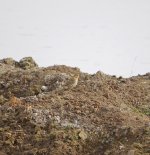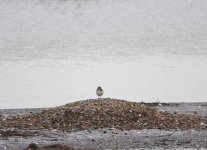-
Welcome to BirdForum, the internet's largest birding community with thousands of members from all over the world. The forums are dedicated to wild birds, birding, binoculars and equipment and all that goes with it.
Please register for an account to take part in the discussions in the forum, post your pictures in the gallery and more.
You are using an out of date browser. It may not display this or other websites correctly.
You should upgrade or use an alternative browser.
You should upgrade or use an alternative browser.
Upton Warren (27 Viewers)
- Thread starter andythomas
- Start date
More options
Who Replied?upstarts1979
Well-known member
Just back from the Mecca.
I intended to spread myself equally between the Moors and flashes today. The Fatal mistake of going to the Flashes 1st saw me spend nearly 6 hours there and only allowed me 15 minutes at the Moors before my permit ran out8-P.
It certainly was a worth while session at the Flashes though.
8 species of waders appeared and I had 3 year ticks.
The force 3ish southerly wind made it feel un-spring like, however there was a bit of 'Vis Mig' going on.
An adult Ringed plover accompanied the 2 LRP's, 2 redshanks appeared at different times and later joined up as a 'couple'. The 5 Avocets looked a little more settled than any of the previous groups. Both Oystercatcher and Lapwings mated, the latter species totalling 18 birds, although still a bit early this would represent the highest breeding numbers for many years. Amongst the flock is a pale, not quite leucistic female. A couple of snipe and 9 curlew were the remaining wader species.
In front of the hide Linnets , pied wagtails, goldfinch dropped onto the short grassy areas to feed. A 'darkish legged' pipit momentarily appeared but was soon lost when a pied wagtail chased it, 2 other pipits also showed on the 'grassy knoll' but they were both meadows. A case of the one that got away.
More linnets moved through with at least 10 seen in one flock. A flock of c30 thrushes and 60 starlings moved through.
Also recorded today were: Teal 32, mallard c30, BHG 40, herring gull, coot 10, Buzzard, green woodpecker, stock dove 2, wood pigeon 60,
The brief visit to the Moors revealed
GCG 4, little grebe 3, cormorant 6, Shoveler 6 (4 males), teal 12, gadwall 4 (2 prs), shelduck pr, pochard 4 (2 prs), tufted 50+, Oystercatcher 4 (2 prs), lapwing 3 (2 males), snipe 4, BHG 160, Herring gull c5,
B John
John
I intended to spread myself equally between the Moors and flashes today. The Fatal mistake of going to the Flashes 1st saw me spend nearly 6 hours there and only allowed me 15 minutes at the Moors before my permit ran out8-P.
It certainly was a worth while session at the Flashes though.
8 species of waders appeared and I had 3 year ticks.
The force 3ish southerly wind made it feel un-spring like, however there was a bit of 'Vis Mig' going on.
An adult Ringed plover accompanied the 2 LRP's, 2 redshanks appeared at different times and later joined up as a 'couple'. The 5 Avocets looked a little more settled than any of the previous groups. Both Oystercatcher and Lapwings mated, the latter species totalling 18 birds, although still a bit early this would represent the highest breeding numbers for many years. Amongst the flock is a pale, not quite leucistic female. A couple of snipe and 9 curlew were the remaining wader species.
In front of the hide Linnets , pied wagtails, goldfinch dropped onto the short grassy areas to feed. A 'darkish legged' pipit momentarily appeared but was soon lost when a pied wagtail chased it, 2 other pipits also showed on the 'grassy knoll' but they were both meadows. A case of the one that got away.
More linnets moved through with at least 10 seen in one flock. A flock of c30 thrushes and 60 starlings moved through.
Also recorded today were: Teal 32, mallard c30, BHG 40, herring gull, coot 10, Buzzard, green woodpecker, stock dove 2, wood pigeon 60,
The brief visit to the Moors revealed
GCG 4, little grebe 3, cormorant 6, Shoveler 6 (4 males), teal 12, gadwall 4 (2 prs), shelduck pr, pochard 4 (2 prs), tufted 50+, Oystercatcher 4 (2 prs), lapwing 3 (2 males), snipe 4, BHG 160, Herring gull c5,
B
upstarts1979
Well-known member
can't tell you, otherwise it wouldn't be a secret8-PWhat does the secret Hen Pool Hide plan consist of?
Only Joking Daniel...Its no secret, we are toying with creating a few more channels in the reeds. These will be positioned so they can be seen from the hide. This will also provide more reed warbler territories by creating physical borders for the birds to defend.
Last edited:
upstarts1979
Well-known member
Sy V
Well-known member
Thanks Rolf "Can you tell what it is yet?" Belsey!
Yes, this is what John and I have discussed, Daniel. Typically, the Sedge Warblers will arrive first but they will get ousted to the rank vegetation on the fringes of the reed beds by the later-arriving Reed Warblers (a mutual friend of ours - Fergus Henderson wrote a paper on this behaviour). The cut channels are an attempt (by us) to allow more separate Reed Warbler territories in the immediate vicinity of the hide.
Yes, this is what John and I have discussed, Daniel. Typically, the Sedge Warblers will arrive first but they will get ousted to the rank vegetation on the fringes of the reed beds by the later-arriving Reed Warblers (a mutual friend of ours - Fergus Henderson wrote a paper on this behaviour). The cut channels are an attempt (by us) to allow more separate Reed Warbler territories in the immediate vicinity of the hide.
Last edited:
upstarts1979
Well-known member
Thanks Rolf "Can you tell what it is yet?" Belsey!
Yes, this is what John and I have discussed, Daniel. Typically, the Sedge Warblers will arrive first but they will get ousted to the rank vegetation on the fringes of the reed beds by the later-arriving Reed Warblers (a mutual friend of ours - Fergus Henderson wrote a paper on this behaviour). The cut channels are an attempt (by us) to allow more separate Reed Warbler territories in the immediate vicinity of the hide.
and to see and photograph the birds in there
upstarts1979
Well-known member
Thanks for that Daniel. the work will be done in a couple of hours so we wont need a formal work party. However the reed bed in the Education reserve will need a lot more work. If we can't get it done on a Tuesday, we will do it on a Sunday..I will post the date if we need to.BAlright, let me know when you want to work on it. Am interested to participate!
... and thanks!
UW82
Well-known member
can't tell you, otherwise it wouldn't be a secret8-P
Only Joking Daniel...Its no secret, we are toying with creating a few more channels in the reeds. These will be positioned so they can be seen from the hide. This will also provide more reed warbler territories by creating physical borders for the birds to defend.
John. Is the idea to produce permanent channels? In the past any channels that have been strimmed in front of the hide have soon regrown with phragmites. Are you going to dig the phraggy out?
Des.
upstarts1979
Well-known member
No Des, just a late cut below the water. The channels in front were cut with shears 2 or 3 times a year.John. Is the idea to produce permanent channels? In the past any channels that have been strimmed in front of the hide have soon regrown with phragmites. Are you going to dig the phraggy out?
Des.
:t:John
UW82
Well-known member
No Des, just a late cut below the water. The channels in front were cut with shears 2 or 3 times a year.
:t:John
OK John. I actually think 2 or 3 permanent channels would be good for viewing purposes, but that might not be possible.
Des.
Gert Corfield
Well-known member

Live from the Flashes this morning, 4 Avocet, 1 LRP flew north 8.30am, 2 Oystercatcher, singing Chiff Chaff. Peregrine through. Mistle Thrush singing. 1 Shelduck. 6 Curlew.
Last edited:
upstarts1979
Well-known member
Gert, Any live commentary from the MoorsLive from the Flashes this morning, 4 Avocet, 1 LRP flew north 8.30am, 2 Oystercatcher, singing Chiff Chaff. Peregrine through. Mistle Thrush singing. 1 Shelduck. 6 Curlew.
Have the redshank gone..they weren't there first thing yesterday, thus they were either on the 3rd Flash or genuine passage migrants.B
Thanks for that Daniel. the work will be done in a couple of hours so we wont need a formal work party. However the reed bed in the Education reserve will need a lot more work. If we can't get it done on a Tuesday, we will do it on a Sunday..I will post the date if we need to.BJohn
We will get it done on Tuesday I am on holiday this week so have all the time in the worldB
upstarts1979
Well-known member
We will get it done on Tuesday I am on holiday this week so have all the time in the worldB
Great stuff Mark..there is even a possibility that Oriole Boy might also be available.
upstarts1979
Well-known member
There is definitely an increase in Mistle thrush and green woodpeckers on and around the reserve this year. To think last years May 'all-dayer' we didn't have either species.BLive from the Flashes this morning, 4 Avocet, 1 LRP flew north 8.30am, 2 Oystercatcher, singing Chiff Chaff. Peregrine through. Mistle Thrush singing. 1 Shelduck. 6 Curlew.
Gavo
Well-known member
There is definitely an increase in Mistle thrush and green woodpeckers on and around the reserve this year. To think last years May 'all-dayer' we didn't have either species.BJohn
Yaffles are one of the species that the BTO are predicting could see a huge increase in numbers due to climate change, I must admit I have seen/heard an increasing number in recent years.
wheatearlp
Well-known member

Highlight of the morning - a Meadow Pipit on the deck in front of the flashes hide!
Gert Corfield
Well-known member

Highlight of the morning - a Meadow Pipit on the deck in front of the flashes hide!
Here's a photo of said Pipit! And a distant shot of the LRP which departed at about 8.30am this morning, hopefully to return with mates..:t:
Attachments
upstarts1979
Well-known member
The first Wheatear (a male) of the year appeared behind the new hide at the Flashes, late morning Hairy birder (Si B)
Similar threads
- Replies
- 1
- Views
- 1K
Users who are viewing this thread
Total: 28 (members: 0, guests: 28)






